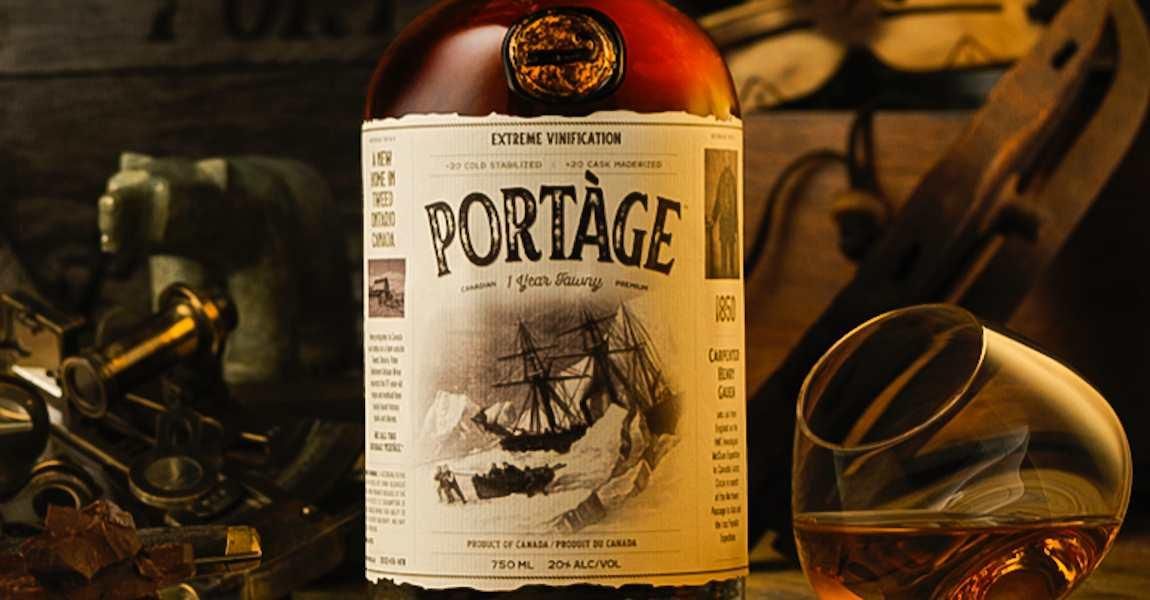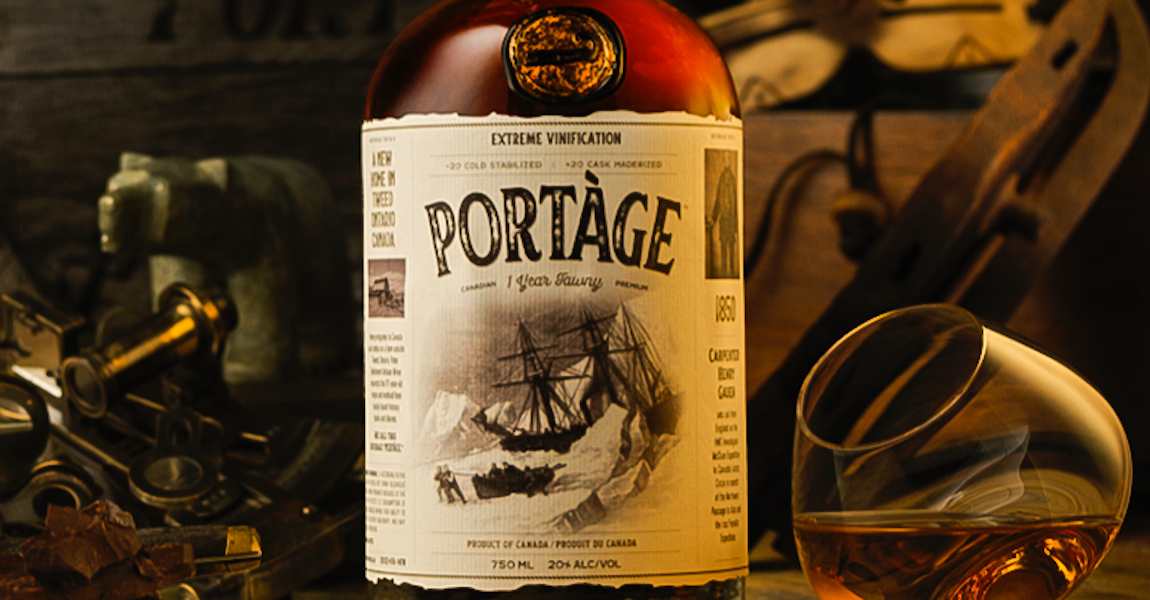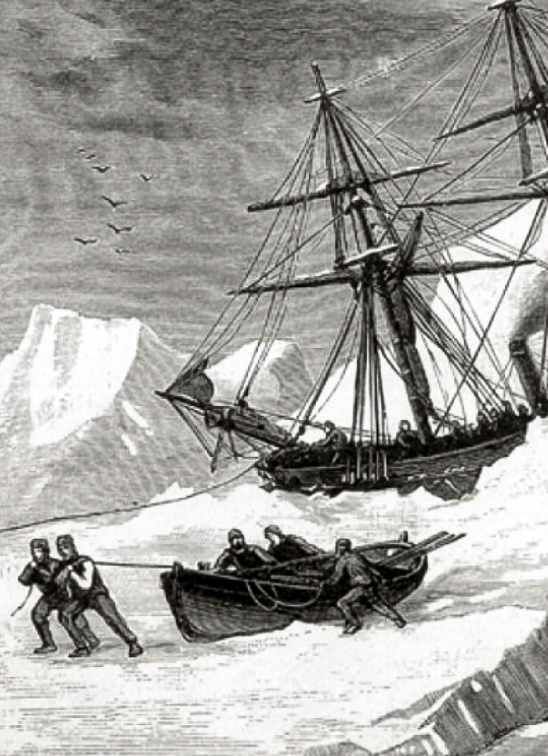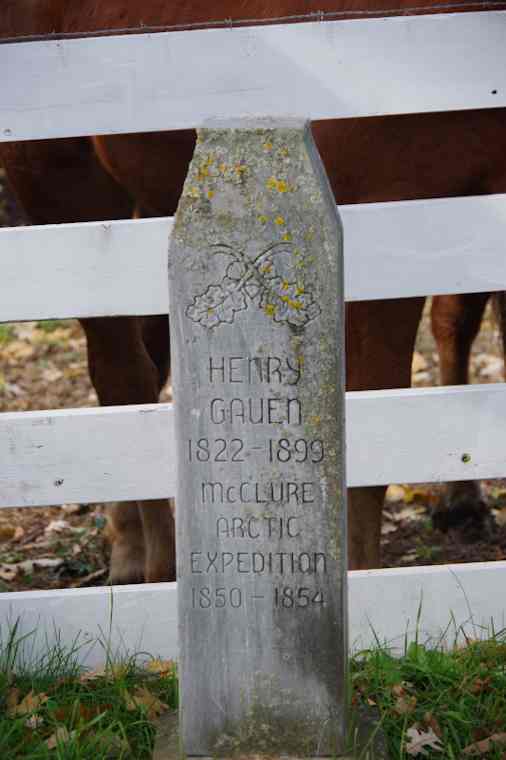A brand new beverage doesn’t come around very often, especially one that is unique, delicious and has a great back story. Rarer still, and perhaps most importantly, a beverage that ties local history to the broader context of our nation’s founding, making it distinctly Canadian, yet also includes the histories of America and Great Britain.
A discovery, in a local barn just outside Tweed, presented an old, dusty trunk to the proprietors of Potter Settlement Artisan Wines. Within, it contained a treasure trove of handwritten diaries, letters and historical documents of residents from the area in the 1800s. Included in those were the accounts of a Mr. Henry Gauen, carpenter of the HMS Investigator on the McClure Arctic Expedition of 1850. Buried outside Tweed in the hamlet of Ivanhoe, Gauen’s humble grave on what was his old farm can be easily seen off Highway 62 by the grain silo. Mr. Gauen was also one of the founders and the first President of the Ivanhoe Cheese Factory, undoubtedly the main business attraction of the hamlet. As a CNN journalist in Tokyo, Japan in my twenties, I was once thrilled to find packages of Ivanhoe cheddar cheese sold at the International Grocery Store located in Roppongi.
I have a personal attachment to Mr. Gauen’s grave site. Long before my journalism days, I boarded in the Fleming home in Ivanhoe as a teenager in high school, right across the road from Mr. Gauen’s burial plot. Daily I would pass it on my way to class. Back then, it was simply a set of faded gravestones surrounded by weeds. Today, it is a local historical attraction maintained by the Lions Club and Melvin Miller, the Amish owner of the former Gauen farm.
Upon learning of his new Arctic sailing assignment in 1849, Mr. Gauen purchased ice skates in London, (England), naively thinking that he would “skate across the North Pole.” Interestingly, as an avid antiques collector even as a teen I was generously gifted a pair of old skates, which, to this day, adorn the shelves of our family winery among other prized collectibles including a Penny Farthing bicycle once owned by hockey superstar Eric Lindros and a vast collection of area minerals. Until I read this letter from Evan Morton, curator of the Tweed Heritage Centre Museum, many decades later, I had not realized the historical significance of these old ice skates.
“Among the papers was the reference to a late Miss Fleming, of Ivanhoe, who had in her possession, “a pair of skates, metal blades attached to wooden boots…which Mr. Gauen used during the expedition. They would make a great addition to our Henry Gauen display! Whatever has happened to them? Spread the word!” I confess, I think I might have an idea.
Henry Gauen’s mission on the HMS Investigator and the expedition of 1850 was two-fold: locate any missing crew of the lost Franklin Expedition, HMS Terror and HMS Erebus ships that had vanished five years prior, then to continue the search for the supposed Northwest Passage. A handsome reward of ten thousand pounds (about a million dollars in today’s money) awaited any one who could discover, map and traverse the passage. The significance of the Northwest passage was that it would provide English merchants a shortcut from Europe to the Pacific Ocean and Asian markets, shaving off thousands of miles of travel time rounding Cape Horn and through the Strait of Magellan at the bottom of South America.
Henry Gauen and the crew of the HMS Investigator became trapped in sea ice in Mercy Bay, Inuvik for three years. Unfortunately, no survivors of the previous Franklin Expedition were ever located. Of that ill-fated expedition, only bones were found scattered across the Arctic, some indicating evidence of cannibalism. Three sailors from Franklin’s crew were found perfectly frozen on Beechey Island, and two other frozen cadavers were discovered in a European rowboat at the McClintock Boat Place on King William Island. At this last site, one of the skeletons was still sitting ghoulishly upright, frozen hands tightly gripping two fully loaded shotguns with forty pounds of cocoa at his feet.
Suggestions of the fleeing Franklin Expedition members dragging grand pianos across the Arctic sea ice as their boats became crushed in the very same ice pack still stir the imagination and manifests not only their naivete but a complete underestimation of their dire predicament. These poor men had no concept that the trappings of civilization, Gauen’s ice skates and pianos alike, were completely out of sync with the cold brutality of their Arctic surroundings.
As with the ill-fated Franklin Expedition, for Henry Gauen and his comrades on the McClure Expedition, conditions also quickly became miserable and deadly. They ran out of food. During their third winter, the warmest they could get the interior of the ship was -11C/12F. Sailors died of scurvy and frostbite, suffered medical complications linked to starvation, and lead poisoning from poorly canned food.
Looking to escape their predicament, while simultaneously continuing their search for the famed Northwest Passage, crew members set out on the frozen sea ice with heavily packed row boat on sleds, hand hauling them across the ice in search for open water and a way out.
Towing these heavy row boats was gruelling work and required the crew to camp out on the open sea ice in temperatures that often dipped to below -60C/-76F. Huddled in the rowboat hull for warmth at night, frozen socks and frostbitten toes had to be removed to offset gangrene. Food was so scarce that there are accounts of the starving sailors “boiling their own leather boots” to make a bitter broth to try and sustain themselves. There are also accounts of the soles of these boots being burned as the sailors wore them, from sitting too close to their campfires in attempts to warm their frozen feet. If one had to urinate, other men would gather and stretch out their frozen hands so that they could be warmed by the stream. Gauen himself was horribly mauled in a polar bear attack and “would have perished had it not been for the courage of his crew who fended the animal off and rescued him. An insight into their mindset during this miserable experience is afforded by the places they named along the route, Terror Harbour, Starvation Cove, and Desperation Bay.
Persevering, the men eventually located two passages of open sea water, the closest only some thirty miles away from the HMS Investigator’s frozen prison in Mercy Bay.
While trekking across the ice in search of the Northwest Passage on these portage sledding excursions, Henry Gauen and the McClure expedition also carried small barrels of Port wine to help sustain them. This Port wine was, according to the ship’s manifest, “purchased from Fortnum & Mason’s Fine Goods at 181 Piccadilly, London.”
Something unusual happened to this wine during those excursions. Subjected to the extreme Arctic temperatures of below -20C it froze. When Port wine freezes, which is normally very difficult to do as it is high in residual sugars and alcohol, typically twenty percent abv, something magical happens: any bitterness in the wine suddenly vanishes. This is a process known as cold stabilization, which removes bitter tartaric acid and salts. Cold causes acids to crystallize and rain down to the bottom of the barrel, making the remaining wine “uncommonly smooth,” as the sailors noted.
The magic didn’t stop there. The following summer, the wine was then oxidized and became “maderized” in ‘The Land of the Midnight Sun’ as the barrels were exposed to the relentless twenty-four hour sunshine beating down on them as they were hauled across the ice during the brief Arctic summer. This created complex caramelization in the Port causing the wine to express interesting toffee and stone fruit flavors, heightening the taste. As an added benefit, the extreme oxidation from the sunshine also made it rather indestructible, giving it a much longer shelf life.
A new beverage has resulted from these extremes unique to the polar regions of Canada. The sailors deemed it “fit for the finest dining tables of Queen Victoria…providing a rare joy to the lips and a moment of heavenly escape for our battered crew in our darkest moments.”
In historical documents, Captain McClure recounted dispensing a small amount to crew members “on their birthdays” to mark the special occasion and momentarily alleviate their desperate suffering.
Ironically, this new beverage became lost to history when in 1854 the British tall ship HMS Resolute rescued Henry Gauen and the few remaining survivors of the McClure Expedition and returned them safely to England. McClure was knighted and the crew was awarded shares of the prize money for their discovery of the Northwest Passage. With his share, Henry Gauen emigrated to Canada to start a farm and a new life in Ivanhoe outside of Tweed.
HMS Resolute, the rescue ship that saved Henry and his crew also later became trapped in the Arctic ice, and was abandoned. It was discovered and eventually freed by an American whaling ship and towed to the United States. As a gesture of goodwill, the Americans gifted the HMS Resolute back to the English, her rightful owners. Reciprocating, the English created a beautiful desk out of the ship’s timbers and gifted it to the Americans. This desk is called The Resolute Desk and is found to this day in the Oval Office of the President of the United States In Washington, D.C.
Interesting indeed. Especially since that desk is made from the ship that rescued poor Henry Gauen who is buried around the corner from our family winery.
To make a fortified wine is simple. Ferment grape juice to six percent abv, retaining the sweetness, then arrest the fermentation with eighty proof brandy. The result is also known as “Port” and that name is owned by the government of Portugal.
If you make it here in Canada, you need give it an original name, much like Sherry Karlo of Karlo Estates Winery in Prince Edward County who calls her fortified wine “Van Alstine” – chosen as an homage to a local settler and owner of a grist mill. According to international law, one might simply call it “Port-like wine,” which is a little short on marketing appeal. Similarly the name “Champagne” is owned by the government of France. To quote Jonas Newman of Hinterland Wine Co. in Hillier, “You can make a sparkling wine and give it any name you want, but you cannot legally call it Champagne unless it’s produced from that specific region in France.”
So herein lies our challenge: we have a brand new beverage from an accidental hundred and seventy year old recipe, created through extreme vinification in the Arctic. So what should we name it?
Our company, Potter Settlement Artisan Wines resurrected this méthod Canadien Port recipe, so we decided call it “PORTÀGE,” as this is exactly what the sailors were doing when it was created. The name is Canadiana and in keeping with the history of the French voyageurs who portaged through our nation’s many rivers centuries ago.
Made with Ontario’s first planting of Frontenac Gris grapes, it’s the daughter of the varietal that the Portuguese use to make a tawny Port. PORTÀGE can only be produced in the climatic conditions that are specific to northern Canada.
Sorry, Portugal. You don’t get conditions cold enough to make it. This one belongs to us and we’re claiming the name, method and style for Canada. We made it. Left it outside in January at -20C to freeze. Then we kept it in barrels in the July sunshine of +30C to cook and oxidize like a Madeira Port, another name legally owned by Portugal.
It is rightly attributed to the tribulations of Henry Gauen’s McClure Expedition, who discovered the results portaging across the Arctic ice while in seeking lost comrades of the Franklin Expedition, and in search of the Northwest Passage. It is now debuting in our winery. Come on over and try it.






